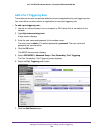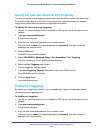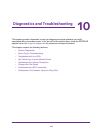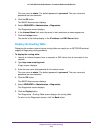
Manage Firewall Rules, Port Forwarding, and Port Triggering
201
AC1200 WiFi DSL Modem Router—Essentials Edition Model D6100
4. Click the OK button.
The BASIC Home screen displays.
5. Select ADVANCED >
Advanced Setup > Port Forwarding / Port Triggering.
The Port Forwarding / Port Triggering screen displays.
6. Select the Port Triggering radio button.
The port triggering settings display
.
7. Clear the Disable Port Triggering
check box.
If this check box is selected, the modem router does not apply port triggering rules even if
you specified them.
8. Click the Apply button.
Your settings are saved.
Application Example: Port Triggering for Internet Relay Chat
Some application servers, such as FTP and IRC servers, send replies to multiple port
numbers. Using port triggering, you can tell the modem router to open more incoming ports
when a particular outgoing port starts a session.
An example is Internet Relay Chat (IRC). Your computer connects to an IRC server at
destination port 6667. The IRC server not only responds to your originating source port but
also sends an “identify” message to your computer on port 1
13. Using port triggering, you can
tell the modem router, “When you initiate a session with destination port 6667, you must also
allow incoming traffic on port 113 to reach the originating computer.”
The following sequence shows the effects of this port triggering rule:
1. You open an IRC client program to start a chat session on your computer.
2. Your IRC client composes a request message to an IRC server using a destination port
number of 6667, the standard port number for an IRC server process.
Your computer then
sends this request message to your modem router.
3. Your modem router creates an entry in its internal session table describing this
communication session between your computer and the IRC server
. Your modem router
stores the original information, performs Network Address Translation (NAT) on the source
address and port, and sends this request message through the Internet to the IRC server.
4. Noting your port triggering rule and observing the destination port number of 6667, your
modem router creates another session entry to send any incoming port 113 traf
fic to your
computer.
5. The IRC server sends a return message to your modem router using the NAT
-assigned
source port (for example, port 33333) as the destination port and the IRC server also sends
an “identify” message to your modem router with destination port 113.
6. When your modem router receives the incoming message to destination port 33333, it
checks its session table to see if a session is active for port number 33333. Finding an
active session, the modem router restores the original address information replaced by NAT
and sends this reply message to your computer
.


















